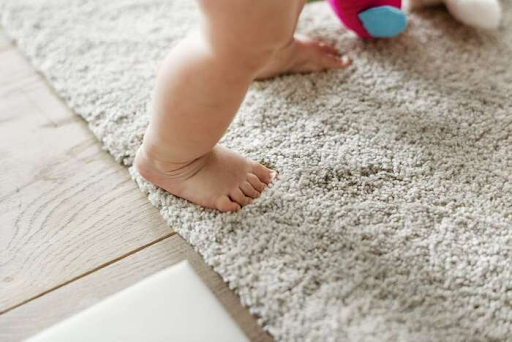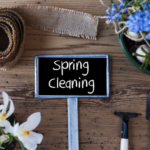For most people, the warmer weather can be a welcome time of year. But, if you’re prone to suffering from allergies like hay fever, this change of season can be something that you dread.
With pollen counts soaring, triggering sniffles, itchy skin, watery eyes and headaches, you might be tempted to stay cooped up indoors with the windows firmly shut. But, even inside, you can’t necessarily escape allergy-triggering substances. Yet, there’s plenty you can do to reduce their impact.
1. The problem with pollen
Pollen produced by plants can travel far and wide by the wind, and it’s not confined to staying outdoors. These tiny plant particles can stick to clothes, hair and the bottom of your shoes, getting tracked indoors. Windows or doors left open can also invite pollen inside, even if they’re opened for the briefest of moments. Pets who roam outside can also bring pollen in on their fur or paws, adding to the problem.
Whether pollen is airborne indoors or walked in on your shoes, it will eventually find its way into a carpet. The dense weave and fabrics that make up a carpet or a rug become ideal places for pollen to become trapped, and as more people walk over them, pollen particles will sink further into the carpet or rug pile.
So, as well as causing misery to hay fever sufferers who go outdoors, pollen trapped inside carpets and rugs can contribute to uncomfortable allergy symptoms inside.
2. Other allergens to consider
But, pollen isn’t the only allergy-triggering baddie you need to worry about.
Other substances can settle into carpets, rugs, upholstery and mattresses, triggering allergy symptoms. These can include dust mites, mould spores, mildew and even pet dander.
So, long after pollen season is over, many sufferers may still not find relief, with other allergens present in the home making their presence known.
The good news is that sufferers can minimise the impact of allergens like pollen or dust mites in the home, by following a number of important strategies.
3. Regular vacuuming
One of the best ways to reduce allergens from settling into carpets, rugs and furnishings is through regular cleaning. In particular, you should get into the habit of vacuuming daily during peak pollen season. Use a vacuum cleaner that has a HEPA filter for maximum elimination of allergens from carpets or rugs, and make sure you frequently clean the filter.
4. Professional cleaning
However, it’s worth bearing in mind that even with regular vacuuming, this won’t be enough to get rid of 100% of allergens residing in a carpet or a rug. That’s because many of the particles get trodden to the bottom of a carpet or rug pile, which is more difficult for a vacuum cleaner to reach.
Plus, vacuuming alone won’t kill off dust mites, so the only effective solution is to make sure your carpets, rugs and furnishings are provided with regular professional cleaning.
Professional carpet and rug cleaning companies use high-tech equipment that deep cleans fabrics to the very bottom of the pile, getting rid of all of those substances that a vacuum cleaner alone can’t reach. Additionally, if dust mites are an issue, the hot water used in professional steam cleaning machines will help to kill them off.
However, always make sure that you use a cleaning company with a good reputation, as some sub-standard cleaners might use ineffective equipment that doesn’t do a good job of removing moisture from carpets, which could then encourage mould and mildew to form.
It’s also worth bearing in mind that, as well as regularly getting carpets and rugs cleaned to remove potential allergens, you should consider getting upholstery, mattresses, furnishing and curtains regularly refreshed, as these can all harbour substances that can trigger allergy symptoms.
5. Keep pets clean
Skin shed by pets can exacerbate allergy symptoms, while pollen, bacteria and fleas can be brought in from outdoors on their fur or paws, all of which can end up affecting your health. Regular cleaning of your pets, such as brushing and washing, as well as keeping on top of any bug-removal treatments, is the answer to keeping health-harming substances at bay.
Plus, if you have a pet that has a favourite bed or rug to sleep on, it’s especially important to get these cleaned frequently.
6. Take your shoes off
Many people are surprised to discover that walking outdoor footwear inside can track allergens like pollen inside the house, because often these substances are hard to see as they’re so small. Therefore, in order to keep unwanted health-harming substances firmly outdoors, take your shoes off before you step inside.
When the pollen count is high, it’s also a good idea to get into the habit of changing your clothes after being outdoors, and taking a shower and washing your hair to prevent pollen being dispersed around the house.
7. Clean stains
Spillages on carpets, especially those that are food- or drink-related, can attract mould and bacteria to form, which can impact your health. So, whenever something is dropped or spilled onto a carpet, or walked into it, spot clean it as best as you can, before calling out the expert carpet cleaners to properly remove all of the stains.
8. Use an air purifier
It might be worth considering using an allergy-rated air purifier in your home, which works to draw out mould, pollen or other allergens from the surrounding atmosphere, before these substances have a chance to land in your carpet.
You can also prevent pollen from entering the house by keeping windows and doors closed as much as possible on days when the pollen count is high.
9. Choose carpet materials with care
While all carpet materials can be prone to attracting allergens, such as dust mites and pollen, and all have a padding that can become wet, encouraging mould and mildew to form, there are certain carpet fabrics which stand up better to reducing the number of allergens they hold onto.
Nylon is an especially popular choice of carpet fabric for those affected by allergens, as its fibres repel mould growth, prevent pollen from flourishing and is easy to clean. Polyester is also a good, anti-allergy carpet material option, and is cheaper than nylon, although not as durable.
While you might be tempted to choose a long-pile carpet for its soft, fluffy fabrics, this is a no-no if you’re susceptible to allergens. Instead, opt for a short-pile carpet with tightly woven strands, which make it harder for allergy-unfriendly substances to get trapped inside fibres, while preventing mould from growing underneath the carpet materials.
Also look for a carpet that has low VOC levels, which are chemicals used to treat a new carpet. Once installed, a new carpet can release these chemicals into the atmosphere, which can cause issues for those who suffer from allergy conditions.
As well as paying attention to a carpet’s materials, consider the underlay, the material used underneath the carpet, as this can also impact the effect of allergens. Natural underlay materials are especially good at absorbing moisture, which can encourage mould or mildew to grow, whereas synthetic underlay materials treated with an antimicrobial agent can repel allergy-triggering substances.
Carpet Bright UK can assist to keep your space allergen-free, with professional carpet, rug, upholstery, mattress and curtain cleaning services. So, why not do your health a favour, and get a free quote today?







